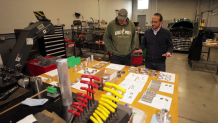Long hailed as an impossibility, harnessing nuclear fusion to power homes, businesses, cars and even airplanes is now widely viewed by scientists and engineers as a very real prospect that would undoubtedly and dramatically reshape energy consumption around the world.
“It's tremendously exciting in that we would have virtually limitless power,” said Carl Bass, chairman of the company Alpha Ring, which is working to capture the power of fusion through miniature nuclear reactors. “It will happen in our lifetime – really, the question for me is just the scale at which it happens.”

Tech companies race to harness nuclear fusion
Get a weekly recap of the latest San Francisco Bay Area housing news. Sign up for NBC Bay Area’s Housing Deconstructed newsletter.
Globally, over 40 companies – including several in California – are now experimenting with more than 20 different methods to harness what is believed to be a cleaner and potentially cheaper energy alternative in nuclear fusion. The race to harness fusion comes as fossil fuels, including oil, coal, and gas, continue to drive climate change with the pollution they emit.
“We really can produce energy at a fraction of the cost with almost none of the problems of the current energy infrastructure,” Bass said. “You could imagine a small reactor in a vehicle, certainly in a boat or a ship – almost everywhere where we need to use either heat or electricity, we could produce it differently and much more cleanly.”
We really can produce energy at a fraction of the cost with almost none of the problems of the current energy infrastructure.
Carl Bass, chairman of Alpha Ring
Alpha Ring’s method, considered by industry leaders to be unconventional, is known as “electron-catalyzed fusion.” The process relies on what the company describes as “miniaturized” nuclear reactors, which are designed to be small enough to fit on a tabletop, but large enough to power entire communities.
“It’s a very complicated technology,” said Steve Hwang, chief operating officer for Alpha Ring, who oversees the company’s laboratories in Monterey, Los Angeles, and Taipei. “If we can produce abundant energy, that's how we're going to change the world.”

Can nuclear fusion ever be commercially viable?
Despite the benefits, one major complication remains – no one has ever been able to turn nuclear fusion into a viable and sustainable energy source. The only place fusion occurs regularly is among the stars – powering, most famously, the sun.
Today, America’s more than 50 nuclear power plants utilize nuclear fission, where atoms are split apart to produce massive amounts of energy, but the process can also emit harmful radiation. Nuclear fusion, on the other hand, relies on atoms being fused together to create bursts of energy. Fusion doesn’t emit carbon or radioactive waste, and the materials needed to create the reaction are plentiful and found all throughout the world.
Unlocking the ability to harness nuclear fusion has largely remained a mystery, however, scientists believe we are the closest we have ever been to creating and sustaining that kind of power.
“Not a matter of if, but when,” said physicist John Edwards, who is a senior advisor at the Lawrence Livermore National Laboratory. Edwards previously served as director of the lab's Inertial Confinement Fusion program for seven years, and was part of the team of government scientists that made history in Dec. 2022 after achieving what was hailed to be the first-ever nuclear fusion reaction inside a lab, where more energy was produced than what it took to jump start the reaction.
“That showed, in principle, you could actually light this fusion fuel in a controlled environment on the earth, and that's the first step that you would need to take to be able to potentially produce this clean, limitless energy for the future.”

Nearly 200 lasers helped ignite first-ever fusion reaction inside a lab
The ignition was sparked by 192 lasers, which used its beams to create temperatures topping 180 million degrees – six times hotter than the center of the sun. The Livermore lab was able to reproduce that success earlier this month, when it achieved a nuclear reaction for the fifth time in 14 months.
While the milestones have proved to be monumental, the amount of energy produced has been far from substantial. Even the lab’s most successful fusion ignition only produced enough power to barely heat up two pots of coffee. In addition, the actual reaction only lasted less than a billionth of a second. To be considered commercially viable, the process would need to generate about 100 times more energy, according to Edwards. Plus, the frequency of reactions would have to increase exponentially – essentially running nonstop.
During the lab's most recent experiment on Feb. 12, the fusion reaction produced 5.2 units of energy, known as megajoules. That represented a net gain of energy when compared to the 2.2 megajoules the lasers "delivered" to spark the reaction, however, it took about 300 megajoules of power to energize the lasers enough to produce the ignition.
Edwards, whose current role at the lab now focuses on how to transform nuclear fusion into a long-term, viable energy source, believes it will require more than just the work of the federal government to dramatically increase efficiency in the process and truly transform fusion into a feasible energy option that can be utilized across the globe.
“If we want to do this relatively rapidly, it's going to be critical that we will be partnering with the private sector,” Edwards said. “It's a consumer product, so without the private industry I don't see how we get there.”

Private companies received $6 billion in investments last year to solve nuclear fusion dilemma
Last year alone, private companies centering on fusion saw an influx of $6.2 billion in investments – that was $1.4 billion more than the previous year, according to the Fusion Industry Association, which represents more than 100 companies activity experimenting on nuclear fusion or working to support the industry, including Mitsubishi Corp. and Google.
“This was something that was always done by governments,” said Andrew Holland, the association’s CEO. “Now the private industry is coming in and saying we see a pathway to making money on this -- and not in 30 years, but in the timeline of a normal venture capital fund, which is a 10 to 15-year fund.”
Holland believes “pilot plants” could begin to pop up over the next 15 years, which would be the first to introduce energy generated by nuclear fusion into the power grid, meaning the process could finally be used to create electricity for homes and businesses.
“Solving that problem would change life in a fundamental way,” said Ed Morse, a Berkeley Professor, engineer, and author on nuclear fusion. “It changes a lot of things.”
Morse, however, said he remains skeptical about tech companies touting scientific solutions to complicated problems that have remained unsolved for decades.
“If anything sounds too good to be true, it probably is,” he said. “Some of these concepts are really bad…others are passable.”
If anything sounds too good to be true, it probably is
Ed Morse, Berkeley professor and engineer, commenting on the surge of tech companies touting their own scientific solutions for how to harness nuclear fusion into a commercial energy source

Alpha Ring vows to submit findings to independent researchers for review
Alpha Ring said its science has led to more than 15 nuclear reactions inside two of its labs. The energy generated each time has generally only been enough to power a light bulb overnight, but the company says some of its reactions have lasted more than 19 hours – which represents a significant increase from the reaction time achieved at the nation’s premiere government lab in Livermore that measured less than a fraction of a second.
“The accomplishment of this is just such a big deal,” Bass said, who also acknowledged the skepticism he and his company face in asserting such a milestone. “One of the important things when you make a claim like this, where many people will be skeptical, is that this will be able to be reproduced by others.”
To prove the company’s nuclear fusion reactions can, in fact, be reproduced, Alpha Ring plans to submit its findings to a slew of scientific journals for review. The company hopes independent researchers will eventually vouch for the technology and its ability to bring star power to Earth.
“This is a huge claim,” Bass said. “So they rightfully are going to take their time, be very skeptical, try to poke holes in it in every way they can because the accomplishment of this is just such a big deal.”
Contact The Investigative Unit
submit tips | 1-888-996-TIPS | e-mail Bigad




